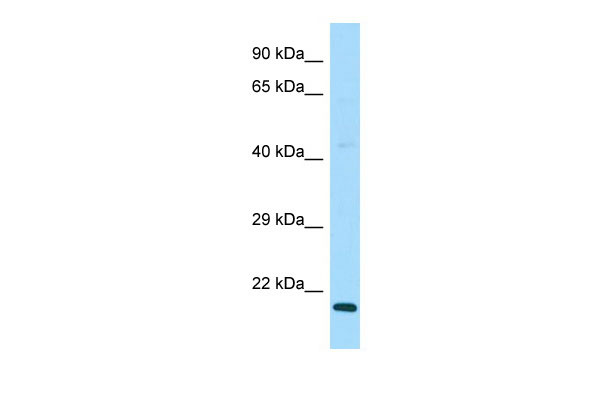DAND5 Antibody - C-terminal region
Rabbit Polyclonal Antibody
- SPECIFICATION
- CITATIONS
- PROTOCOLS
- BACKGROUND

Application
| WB |
|---|---|
| Primary Accession | Q8N907 |
| Other Accession | NM_152654, NP_689867 |
| Reactivity | Human |
| Predicted | Human |
| Host | Rabbit |
| Clonality | Polyclonal |
| Calculated MW | 21kDa |
| Gene ID | 199699 |
|---|---|
| Alias Symbol | CER2, CERL2, CKTSF1B3, COCO, CRL2, DANTE, GREM3, MGC126849, SP1 |
| Other Names | DAN domain family member 5, Cerberus-like protein 2, Cerl-2, Cysteine knot superfamily 1, BMP antagonist 3, Gremlin-3, DAND5, CER2, CKTSF1B3, GREM3, SP1 |
| Format | Liquid. Purified antibody supplied in 1x PBS buffer with 0.09% (w/v) sodium azide and 2% sucrose. |
| Reconstitution & Storage | Add 50 ul of distilled water. Final anti-DAND5 antibody concentration is 1 mg/ml in PBS buffer with 2% sucrose. For longer periods of storage, store at 20°C. Avoid repeat freeze-thaw cycles. |
| Precautions | DAND5 Antibody - C-terminal region is for research use only and not for use in diagnostic or therapeutic procedures. |
| Name | DAND5 |
|---|---|
| Function | Antagonist of the extracellular signaling protein NODAL, which is required for correct left-right patterning during embryonic development (By similarity). Antagonist of BMP and TGF-beta signaling (PubMed:33587337). Independently of its role in left-right axis establishment, plays a role during heart development, possibly through the regulation of TGF-beta/Nodal signaling pathway (By similarity). Displays anti-angiogenic activity by inhibiting endothelial sprouting, migration, and proliferation. Once internalized by endothelial cells, may alter their redox and glycolytic balance (PubMed:33587337). |
| Cellular Location | Secreted. Note=Circulating DAND5 may be uptaken by endothelial cells and transported to mitochondria |
| Tissue Location | Expressed in the retina, in inner segments of photoreceptors, at or close to the outer plexiform layer and in the ganglion cell layer (at protein level). |

Thousands of laboratories across the world have published research that depended on the performance of antibodies from Abcepta to advance their research. Check out links to articles that cite our products in major peer-reviewed journals, organized by research category.
info@abcepta.com, and receive a free "I Love Antibodies" mug.
Provided below are standard protocols that you may find useful for product applications.
References
Itoh N.,et al.Submitted (AUG-2001) to the EMBL/GenBank/DDBJ databases.
Ota T.,et al.Nat. Genet. 36:40-45(2004).
Katoh M.,et al.Oncol. Rep. 12:423-427(2004).
If you have used an Abcepta product and would like to share how it has performed, please click on the "Submit Review" button and provide the requested information. Our staff will examine and post your review and contact you if needed.
If you have any additional inquiries please email technical services at tech@abcepta.com.













 Foundational characteristics of cancer include proliferation, angiogenesis, migration, evasion of apoptosis, and cellular immortality. Find key markers for these cellular processes and antibodies to detect them.
Foundational characteristics of cancer include proliferation, angiogenesis, migration, evasion of apoptosis, and cellular immortality. Find key markers for these cellular processes and antibodies to detect them. The SUMOplot™ Analysis Program predicts and scores sumoylation sites in your protein. SUMOylation is a post-translational modification involved in various cellular processes, such as nuclear-cytosolic transport, transcriptional regulation, apoptosis, protein stability, response to stress, and progression through the cell cycle.
The SUMOplot™ Analysis Program predicts and scores sumoylation sites in your protein. SUMOylation is a post-translational modification involved in various cellular processes, such as nuclear-cytosolic transport, transcriptional regulation, apoptosis, protein stability, response to stress, and progression through the cell cycle. The Autophagy Receptor Motif Plotter predicts and scores autophagy receptor binding sites in your protein. Identifying proteins connected to this pathway is critical to understanding the role of autophagy in physiological as well as pathological processes such as development, differentiation, neurodegenerative diseases, stress, infection, and cancer.
The Autophagy Receptor Motif Plotter predicts and scores autophagy receptor binding sites in your protein. Identifying proteins connected to this pathway is critical to understanding the role of autophagy in physiological as well as pathological processes such as development, differentiation, neurodegenerative diseases, stress, infection, and cancer.


